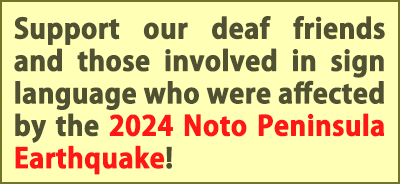from November 2003 Issue of Japanese Deaf News, JFD’s monthly newspaper:
Statement by the Japanese Federation of the Deaf – October 17, 2003
A “Petition for Redress of Human Rights” was submitted to the Japan Federation of Bar Associations in May 2003. The pleaders were 107 Deaf children and parents. Their claim is that the Ministry of Education, Culture, Sports, Science and Technology (hereafter called MEXT) should recognize and approve the use of “Japanese Sign Language” for teaching in Deaf schools, to give training in “Japanese Sign Language” to teachers in Deaf schools, and to include “Japanese Sign Language” as one of the subject for training teachers of Deaf schools.
This Petition was taken up extensively by the media. At the 2003 General Assembly of the Japanese Federation of the Deaf (hereafter called JFD), many members expressed concern about the consistency of the contents of the Petition and the Deaf movement led by JFD. The following explains the standpoint of JFD concerning this issue:
Sign Language is indispensable for the linguistic development of Deaf children. Sign Language is needed for Deaf children to be empowered to live with a proper understanding and awareness of their disability. Based on this concept, JFD established its Education Section at an early stage in its history, and has been advocating strongly with MEXT for the use of Sign Language in Deaf schools. In order to develop mutual understanding with people involved in the education field, JFD has been holding the “Future of Deaf Education Study Conference” once every year since 1989. With the basic theme of “Use of Sign Language in Deaf Schools”, JFD has held numerous discussions and exchanges of opinions with teachers of Deaf schools.
This basic theme toward which JFD has been striving may seem to coincide with the claim stated in the Petition for Redress of Human Rights.
However, an examination of the actual contents of the Petition reveals several basic differences in the way of thinking from that of JFD.
First, the Petition divides Sign Language into “Japanese Sign Language” and “Sign Language adapted to spoken Japanese” and draws a sharp line between the two. Although the two may be divided in a theoretical research on Sign Language as a language, but the Sign Language actually used for communication by the Deaf population varies greatly from person to person and cannot be divided so easily. The definition and explanation of “Japanese Sign Language” in the Petition poses no problems in abstract theory, but would become the subject of much debate when it has to be demonstrated in concrete terms. It would not be surprising to find differences in opinion even among the pleaders of the case.
To separate Sign Language from the actual communication of the Deaf, and to force a categorization under an abstract, theoretical definition would be to impose an unnatural classification on the reality of Deaf persons, and implicates the fear of disrupting the Deaf community. Moreover, if such a division should lead to debates on the comparative merits and demerits of each form of communication, it may even lead to new violations of human rights.
JFD considers that at this point, the common objective should be the introduction of Sign Language education in a broad meaning, and to realize the guarantee of communication in Sign Language among the students in all Deaf schools throughout the country.
JFD also has its views on the “violations of human rights” stated in the Petition. JFD considers the introduction of Sign Language in its broad meaning to be the priority issue. The division of Sign Language into “Japanese Sign Language” and “Sign Language adapted to spoken Japanese” as stated in the Petition is unrealistic, and all the more so in the education field, for reasons explained above. To say that all the issues stated in the Petition are “violations of human rights” would give the false impression that reforms in the school system can be realized overnight. At present, there are no immediate remedies in relation to Sign Language education.
Then how should we go about improving the situation? First, we should promote the employment of Deaf teachers in Deaf schools. These Deaf teachers should cooperate with other members of the faculty as well as the parents of the students to increase an awareness of the importance of Sign Language throughout the school. We must also develop a curriculum adapted to teaching in Sign Language. We should also learn from the 50-year history of the Deaf movement, in which the nationwide promulgation of Sign Language opened the way to the establishment of Sign Language interpreter systems, and conduct a persistent and wide encompassing movement toward our goals.
Lastly, the big issue is what exactly do we mean by Sign Language? This is a big issue even among the Deaf. JFD cannot support the pleaders’ method of relying on the Japan Federation of Bar Associations, which has no direct connections to Sign Language, to decide on its definition.
JFD will continue its movement, together with the Deaf community as well as Deaf persons with multiple disabilities and learners of Sign Language, to aim at social reforms. Within this movement, JFD will strive to deepen understanding on Deaf education, encourage reforms within the schools, promote studies on Sign Language, and continue to advocate with the government.


